非谓语动词作状语
- 格式:pdf
- 大小:122.59 KB
- 文档页数:4

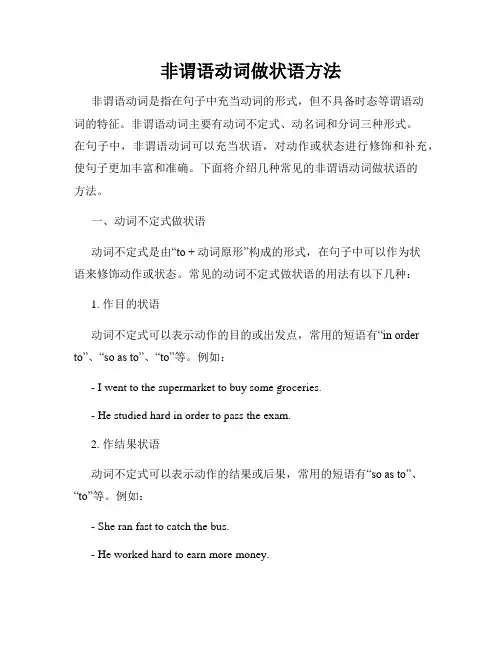
非谓语动词做状语方法非谓语动词是指在句子中充当动词的形式,但不具备时态等谓语动词的特征。
非谓语动词主要有动词不定式、动名词和分词三种形式。
在句子中,非谓语动词可以充当状语,对动作或状态进行修饰和补充,使句子更加丰富和准确。
下面将介绍几种常见的非谓语动词做状语的方法。
一、动词不定式做状语动词不定式是由“to + 动词原形”构成的形式,在句子中可以作为状语来修饰动作或状态。
常见的动词不定式做状语的用法有以下几种:1. 作目的状语动词不定式可以表示动作的目的或出发点,常用的短语有“in order to”、“so as to”、“to”等。
例如:- I went to the supermarket to buy some groceries.- He studied hard in order to pass the exam.2. 作结果状语动词不定式可以表示动作的结果或后果,常用的短语有“so as to”、“to”等。
例如:- She ran fast to catch the bus.- He worked hard to earn more money.动词不定式可以表示动作的方式,常用的短语有“to”、“in order to”等。
例如:- They danced together to celebrate the victory.- He spoke loudly to make himself heard.4. 作原因状语动词不定式可以表示动作的原因,常用的短语有“for”、“to”等。
例如:- She apologized to him for being late.- He thanked her for helping him.二、动名词做状语动名词是由动词加上-ing构成的名词形式,具有动词和名词的特点,可以作为状语来修饰动作或状态。
常见的动名词做状语的用法有以下几种:1. 作原因状语动名词可以表示动作的原因,常用的短语有“by”、“by means of”等。
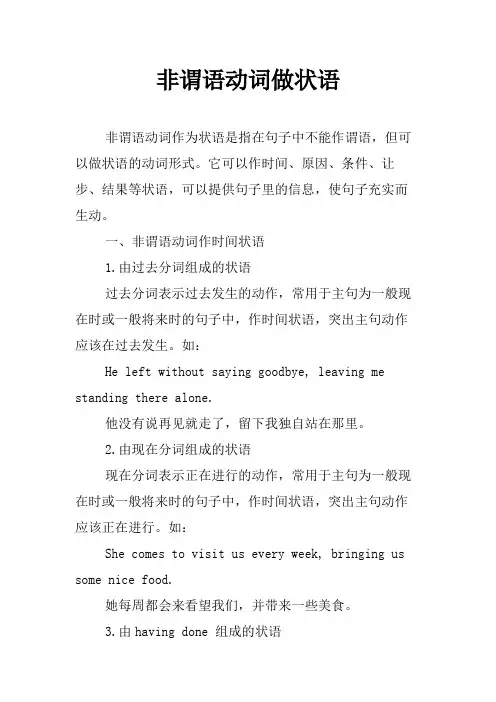
非谓语动词做状语非谓语动词作为状语是指在句子中不能作谓语,但可以做状语的动词形式。
它可以作时间、原因、条件、让步、结果等状语,可以提供句子里的信息,使句子充实而生动。
一、非谓语动词作时间状语1.由过去分词组成的状语过去分词表示过去发生的动作,常用于主句为一般现在时或一般将来时的句子中,作时间状语,突出主句动作应该在过去发生。
如:He left without saying goodbye, leaving me standing there alone.他没有说再见就走了,留下我独自站在那里。
2.由现在分词组成的状语现在分词表示正在进行的动作,常用于主句为一般现在时或一般将来时的句子中,作时间状语,突出主句动作应该正在进行。
如:She comes to visit us every week, bringing us some nice food.她每周都会来看望我们,并带来一些美食。
3.由having done 组成的状语having done 表示过去已经完成的动作,常用于主句为一般现在时或一般将来时的句子中,作时间状语,突出主句动作应该在过去完成的动作之后发生。
如:Having finished the exam, he went home and had a good rest.考试结束之后,他回家好好休息了。
二、非谓语动词作原因状语由because of,due to,owing to,thanks to等引导,接名词或动词不定式,作原因状语,表示主句动作的原因。
如:Because of the heavy rain, we had to cancel our picnic.由于下雨,我们不得不取消野餐了。
三、非谓语动词作条件状语由if,unless,in case,on condition that,provided (that),supposing (that)等引导,接动词不定式,作条件状语,表示“假设”的意思,表示主句动作的前提,即要想主句动作成立,必须满足什么条件。


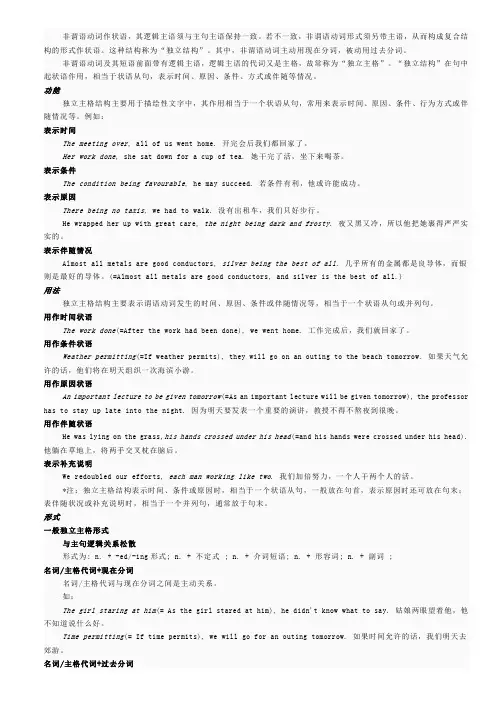
非谓语动词作状语,其逻辑主语须与主句主语保持一致。
若不一致,非谓语动词形式须另带主语,从而构成复合结构的形式作状语。
这种结构称为“独立结构”。
其中,非谓语动词主动用现在分词,被动用过去分词。
非谓语动词及其短语前面带有逻辑主语,逻辑主语的代词又是主格,故常称为“独立主格”。
“独立结构”在句中起状语作用,相当于状语从句,表示时间、原因、条件、方式或伴随等情况。
功能独立主格结构主要用于描绘性文字中,其作用相当于一个状语从句,常用来表示时间、原因、条件、行为方式或伴随情况等。
例如:表示时间The meeting over, all of us went home. 开完会后我们都回家了。
Her work done, she sat down for a cup of tea. 她干完了活,坐下来喝茶。
表示条件The condition being favourable, he may succeed. 若条件有利,他或许能成功。
表示原因There being no taxis, we had to walk. 没有出租车,我们只好步行。
He wrapped her up with great care, the night being dark and frosty. 夜又黑又冷,所以他把她裹得严严实实的。
表示伴随情况Almost all metals are good conductors, silver being the best of all. 几乎所有的金属都是良导体,而银则是最好的导体。
(=Almost all metals are good conductors, and silver is the best of all.)用法独立主格结构主要表示谓语动词发生的时间、原因、条件或伴随情况等,相当于一个状语从句或并列句。
用作时间状语The work done(=After the work had been done), we went home. 工作完成后,我们就回家了。
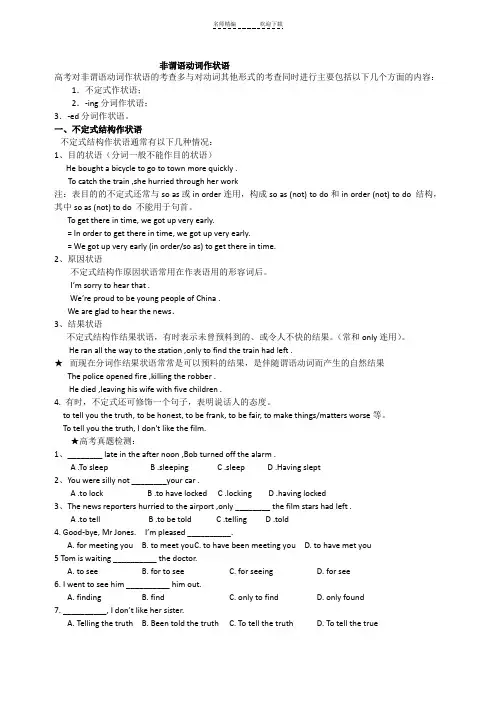
非谓语动词作状语高考对非谓语动词作状语的考查多与对动词其他形式的考查同时进行主要包括以下几个方面的内容:1.不定式作状语;2.-ing分词作状语;3.-ed分词作状语。
一、不定式结构作状语不定式结构作状语通常有以下几种情况:1、目的状语(分词一般不能作目的状语)He bought a bicycle to go to town more quickly .To catch the train ,she hurried through her work注:表目的的不定式还常与so as或in order连用,构成so as (not) to do和in order (not) to do 结构,其中so as (not) to do 不能用于句首。
To get there in time, we got up very early.= In order to get there in time, we got up very early.= We got up very early (in order/so as) to get there in time.2、原因状语不定式结构作原因状语常用在作表语用的形容词后。
I’m sorry to hear that .We’re proud to b e young people of China .We are glad to hear the news.3、结果状语不定式结构作结果状语,有时表示未曾预料到的、或令人不快的结果。
(常和only连用)。
He ran all the way to the station ,only to find the train had left .★而现在分词作结果状语常常是可以预料的结果,是伴随谓语动词而产生的自然结果The police opened fire ,killing the robber .He died ,leaving his wife with five children .4. 有时,不定式还可修饰一个句子,表明说话人的态度。
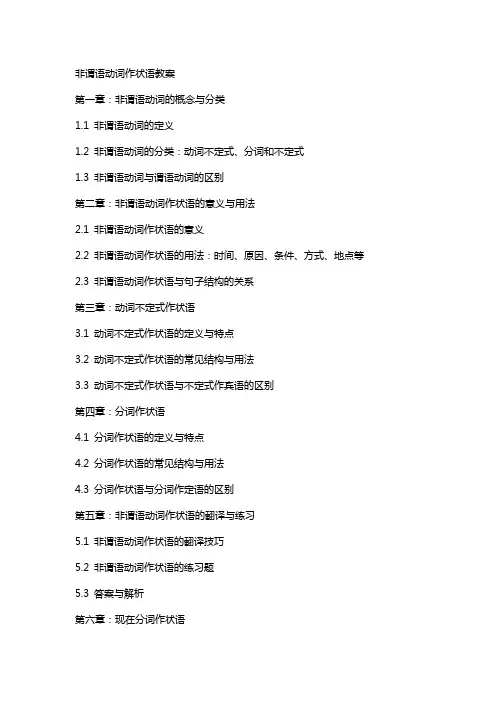
非谓语动词作状语教案第一章:非谓语动词的概念与分类1.1 非谓语动词的定义1.2 非谓语动词的分类:动词不定式、分词和不定式1.3 非谓语动词与谓语动词的区别第二章:非谓语动词作状语的意义与用法2.1 非谓语动词作状语的意义2.2 非谓语动词作状语的用法:时间、原因、条件、方式、地点等2.3 非谓语动词作状语与句子结构的关系第三章:动词不定式作状语3.1 动词不定式作状语的定义与特点3.2 动词不定式作状语的常见结构与用法3.3 动词不定式作状语与不定式作宾语的区别第四章:分词作状语4.1 分词作状语的定义与特点4.2 分词作状语的常见结构与用法4.3 分词作状语与分词作定语的区别第五章:非谓语动词作状语的翻译与练习5.1 非谓语动词作状语的翻译技巧5.2 非谓语动词作状语的练习题5.3 答案与解析第六章:现在分词作状语6.1 现在分词作状语的定义与特点6.2 现在分词作状语的常见结构与用法6.3 现在分词作状语与过去分词作状语的区别第七章:过去分词作状语7.1 过去分词作状语的定义与特点7.2 过去分词作状语的常见结构与用法7.3 过去分词作状语与现在分词作状语的区别第八章:非谓语动词作状语的句子分析8.1 非谓语动词作状语的句子结构分析8.2 非谓语动词作状语的句子类型分析8.3 非谓语动词作状语的句子实例分析第九章:非谓语动词作状语的语法辨析9.1 非谓语动词作状语与作宾语的语法辨析9.2 非谓语动词作状语与作定语的语法辨析9.3 非谓语动词作状语与作补语的语法辨析第十章:非谓语动词作状语的综合练习与解答10.1 非谓语动词作状语的综合练习题10.2 答案与解析10.3 非谓语动词作状语的实践与应用重点和难点解析一、非谓语动词的分类:动词不定式、分词和不定式补充说明:动词不定式作状语时,常常表示目的、结果、原因等;分词作状语时,可以表示时间、原因、条件等;不定式作状语时,通常表示方式、地点等。

非谓语动词作状语逻辑主语和动词的主被动关系-概述说明以及解释1.引言1.1 概述非谓语动词作状语以及逻辑主语和动词的主被动关系是语法学中重要的概念,对于理解句子的结构和意义起着关键的作用。
非谓语动词可以以动词、形容词、副词和介词短语的形式出现在句子中,并且在句子中起到修饰或补充动词的作用。
有时,非谓语动词能够包含丰富的信息,使句子更具表达力和准确性。
逻辑主语是一个概念,指的是在一个句子中承担实际动作或状态的实体或事物。
逻辑主语与动词之间存在着主被动关系,也就是动词所表示的动作或状态是由逻辑主语所承担的。
主动语态表示逻辑主语执行动作,而被动语态则表示逻辑主语接受动作。
本文旨在探讨非谓语动词作状语的定义、分类和用法,并且分析非谓语动词作状语的实际运用。
同时,我们还将深入研究逻辑主语和动词的主被动关系,介绍逻辑主语的定义和作用,以及动词的主被动关系的规律。
通过示例分析,我们将展示非谓语动词作状语和逻辑主语与动词的主被动关系的重要性和实际应用。
最后,本文的结论将总结非谓语动词作状语的重要性,并归纳逻辑主语和动词的主被动关系的规律。
同时,本文也将探讨对语言学研究的启示,以期为语法学领域的进一步研究提供参考和借鉴。
通过对非谓语动词作状语和逻辑主语与动词的主被动关系的深入理解和应用,我们可以更好地理解句子的结构和意义,提高语言表达的准确性和流利性。
1.2 文章结构2.1 定义和分类:在本章中,我们将探讨非谓语动词作状语的相关概念和分类。
非谓语动词是指在句子中作除谓语外的其他成分的动词形式。
它们可以用来修饰主语、谓语、宾语以及其他成分,起到状语的作用。
根据用途和形式的不同,非谓语动词可以分为分词、不定式和动名词等几种类型。
首先,我们来看分词。
分词分为现在分词和过去分词两种形式。
现在分词通常以-ing结尾,而过去分词则是根据动词的不同规则变化而来。
分词作状语时,可以表达时间、条件、原因、方式、目的等不同的意义。
其次,不定式是另一种常见的非谓语动词形式。
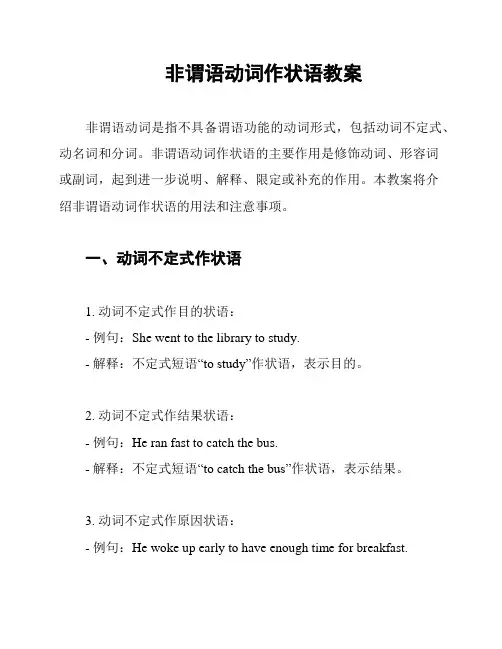
非谓语动词作状语教案非谓语动词是指不具备谓语功能的动词形式,包括动词不定式、动名词和分词。
非谓语动词作状语的主要作用是修饰动词、形容词或副词,起到进一步说明、解释、限定或补充的作用。
本教案将介绍非谓语动词作状语的用法和注意事项。
一、动词不定式作状语1. 动词不定式作目的状语:- 例句:She went to the library to study.- 解释:不定式短语“to study”作状语,表示目的。
2. 动词不定式作结果状语:- 例句:He ran fast to catch the bus.- 解释:不定式短语“to catch the bus”作状语,表示结果。
3. 动词不定式作原因状语:- 例句:He woke up early to have enough time for breakfast.- 解释:不定式短语“to have enough time for breakfast”作状语,表示原因。
二、动名词作状语1. 动名词作时间状语:- 例句:I enjoy swimming in the morning.- 解释:动名词短语“swimming in the morning”作状语,表示时间。
2. 动名词作原因状语:- 例句:She failed the exam due to not studying enough.- 解释:动名词短语“not studying enough”作状语,表示原因。
三、分词作状语1. 现在分词作时间状语:- 例句:Walking along the street, she noticed a bookstore.- 解释:现在分词短语“Walking along the street”作状语,表示时间。
2. 过去分词作原因状语:- 例句:Feeling tired, he decided to take a break.- 解释:过去分词短语“Feeling tired”作状语,表示原因。

非谓语动词做状语在写作中的应用非谓语动词包括动词不定式、动名词和分词(现在分词和过去分词),它们在写作中做状语时可以丰富句子表达,增强文采。
一.动词不定式做状语1.目的状语可以用来表示目的,常放于句首或句末。
例如,“To improve my English, I read English novels every day.”(为了提高我的英语水平,我每天读英语小说),这里的“To improve my English”表明了读书这个行为的目的。
在句尾时,如“I get up early to catch the first bus.”(我早起是为了赶上头班车)。
2.结果状语常与“only”连用,表示出乎意料的结果。
例如,“He rushed to the station only to find the train had left.”(他匆忙赶到车站,结果却发现火车已经开走了)。
二.现在分词做状语1.时间状语当分词的动作与主句的动作同时发生时,可以用现在分词作时间状语。
例如,“Walking in the park, I met an old friend.”(在公园里散步的时候,我遇到了一位老朋友),“Walking in the park”这个动作和“met an old friend”同时发生。
2.原因状语表原因,相当于一个原因状语从句。
如“Being ill, he didn't go to school.”(因为生病了,他没去上学),这里“Being ill”是他没去上学的原因。
3.伴随状语表示伴随状况,与主句的动作同时进行。
比如,“The girl sat there, reading a book.”(女孩坐在那儿,读着一本书),“reading a book”伴随“sat”这个动作。
过去分词做状语1.时间状语和现在分词类似,当过去分词表示的动作先于主句动作时,可作时间状语。
非谓语作状语的5种形式非谓语动词作状语主要有以下五种形式:1. 分词作状语(现在分词和过去分词)- 现在分词表示主动和进行,通常表示时间、原因、条件或伴随状况。
- 过去分词表示被动和完成,通常表示时间、原因、条件或伴随状况。
Example:- (现在分词) Running in the park, I found a lost wallet.- (中文翻译) 在公园跑步时,我找到了一个丢失的钱包。
- (过去分词) Given more time, I could finish the task.- (中文翻译) 如果给我更多的时间,我就能完成这个任务。
2. 不定式作状语- 表示目的、结果或原因。
Example:- (目的) To improve my English, I read books in English every day.- (中文翻译) 为了提高我的英语水平,我每天阅读英文书籍。
- (结果) He worked hard to pass the exam, only to fail.- (中文翻译) 他努力工作以通过考试,结果却失败了。
- (原因) To see her smile is to understand her happiness.- (中文翻译) 看到她的微笑就能理解她的幸福。
3. 句子作状语- 通常是一个完整的句子,用来修饰主句,表示原因、条件、时间等。
Example:- (原因) Because it was raining, we canceled the trip.- (中文翻译) 因为下雨,我们取消了旅行。
- (条件) If it rains, we will stay at home.- (中文翻译) 如果下雨,我们就待在家里。
- (时间) When the bell rings, the class will start.- (中文翻译) 当铃声响起时,课程就开始了。
非谓语动词作状语在成份上,非谓语动词都可以作状语.在时态上,ing表"进行",ed表"完成",在语态上,ing 表"主动",ed表"被动".在概念上,ing表"抽象,习惯",不定式表"具体,偶然,将来".非谓语动词(非谓)做状语主要就是要把握非谓与主句主语的"主被动关系"和主句"动作发生的先后顺序".一般说来,在时间上,非谓的一般式与谓语动作同时发生,完成式先于谓语动作之前发生,进行式在谓语动词动作发生时正在进行.(注意否定词not要加在非谓前)eg: They had a good time at the party, singing and dancing. (一般式)(在派对上玩和唱歌跳舞是同时的,且与主语they呈主动关系)Having waited in the queue for half an hour, the old man suddenly realized he had left the cheque in the car. (完成式)(排队等了半个小时后,那个老人忽然意识到自己把支票忘在车上了."排队"这个动作发生在"意识到忘带支票之前")They seemed to be eating something that they had cooked on the fire. (进行式,常常是不定式的进行式.)二.详解1. 不定式作状语表示目的,结果,原因等.其逻辑主语必须是句子的主语,如果不是则要加上其自身的主语,即独立主格结构.(ing和ed也一样).不定式要把握以下几点:*表目的用不定式 eg: To finish the work before time, we'd better ask Tom for help. 为了提前完成工作,我们最好找Tom帮忙.* 动作还没发生,将来的,用不定式.*表出乎意料的结果要用不定式.eg: 我们终于到了那里,却发现没有人在那里.In the end, we arrived there only to find nobody there. (对)In the end, we arrived there only finding nodody there. (错)现在分词在句中作结果时表示意料之中的事,而不定式表意料不到的事情.2.分词作状语形式意义ing与逻辑主语呈主动关系,与主句动作同时发生,或基本上同时发生.having done与逻辑主语为主动关系,动作发生在主句动作之前.done与逻辑主语为被动关系,动作完成.being + done 与逻辑主语为被动关系,与为主动作同时发生,一般作原因状语,放名首.having been done与逻辑主语为被动关系,先于主句动作发生.eg: Given more time, he would finish the plan. 多给些时间他就能完成计划.Getting off the bus, she saw her mother. 一下车她就看见了她妈妈.Having passed the exam, she told everybody the good news.通过了考试后,她把这个好消息告诉了每个人.Having been told many times, she still couldn't understand me.跟她说了很多次她还是不能理解我的意思.Being asked to give a speech, she didn't know how to refuse.被邀做演讲时,她不知道怎么拒绝.注:以上各点也适用于非谓语动词做其它成份的情况.混合练习(按步骤:*找主语 *找主句谓语 *判断非谓与主语的主被动关系 *比较非谓和主句动作先后,对照上表来做就不容易出错了)1 _____ their service, the workers of the hotel are active in learning English.A. ImprovingB. To improveC. ImprovedD. Having improved【解析】本题考查非谓语动词作状语。
非谓语动词作状语全解不定式和分词作状语的用法一、不定式作状语可以作:1。
主要用作目的状语。
常与 in order to do (为了或 so as to do(以便连用。
so as to 不用于居首。
He got up early in order to catch the first bus. 他早起为了赶上第一班车。
He sat down to have a rest。
他坐下来休息。
He went to France to learn French. 他去法国学习法语.They stood by the roadside to talk about the plan.他们站在路边为的是谈论这个计划。
They stopped to ask the way. 他们停下来问路. (停下来的目的2。
作结果状语。
表示出乎意料的结果。
做结果状语的不定式只能出现在句子的末尾,常见的不定式动词有:to find, to hear, to see, to be told, to form, to give, to make,to produce 等。
He hurried to the station only to find the train gone. 他匆匆忙忙地赶到火车站,发现火车已经开走了.He woke up to find everybody gone。
他醒来发现大家都走了。
His family was too poor to support him。
他的家庭太穷,不能维持他的生活. The boy is not tall enough to reach the book shelf。
这男孩个子不够高, 手伸不到书架。
He is old enough to go to school。
他到上学年龄了.He lifted a rock only to drop it on his own feet.他搬起石头砸了自己的脚。
非谓语动词作状语非谓语动词是指不具有谓语功能的动词形式,常常充当句子中的修饰成分,起到修饰动词、形容词、副词或名词等作用。
在英语中,非谓语动词包括不定式、动名词和分词。
本篇文章将以不定式、动名词和分词分别为依据,介绍非谓语动词作状语的用法和例句。
这些例句都是常见的日常生活和工作场景,希望能对大家的英语学习有所帮助。
(一)不定式作状语不定式是指由to加动词原形构成的动词形式,作为非谓语动词充当状语时,主要表达的是目的、结果、原因、方式、条件等语义。
1. 作目的状语不定式作目的状语常常放在句子前面,表示为了什么目的而去做某事。
- In order to finish the project on time, we worked overtime.- 为了按时完成项目,我们加班工作。
- He left early so as to catch the train.- 他早早离开以便赶上火车。
2. 作结果状语不定式作结果状语表示某个行动或决定的结果。
- He refused to help his sister, causing her great disappointment. - 他拒绝帮助妹妹,使她感到极度失望。
- She failed to complete the task, resulting in a delay.- 她未能完成任务,导致了延误。
3. 作原因状语不定式作原因状语表示为什么会发生某件事情。
- She woke up early to prepare breakfast for her family.- 她早早醒来为家人准备早餐。
- John stayed up late to finish his homework.- 约翰熬夜完成他的作业。
4. 作方式状语不定式作方式状语表示行动的方式。
- He drove carefully to avoid accidents on the icy road.- 他小心地驾驶以避免在冰路上发生事故。
非谓语动词作状语一不定式作状语(to)do/not(to)do1表目的He sat down to have a rest.They went there to visit their teacher.2.表示结果He is old enough to go to school.。
She is too tired to do the job.。
表出乎意料的结果:______________He woke up only/just to find everybody gone.他醒来发现大家都走了。
3表示原因在某些形容词作表语,表示喜、怒、衷、乐后跟不定式表示原因。
如:I am very glad to see you.I am so sorry to hear your mother is ill.4.强调动词不定式所表示的目的时,动词不定式可用in order to do(为了)或so as to(以便)+do。
注意:so as to不用于句首。
He got up early in order to/so as to catch the first bus.In order to pick up passengers,the bus stopped。
5.修饰全句,独立成分To tell you the truth,I have got no money about me.To be honest,I know nothing about it.二分词作状语分词作状语1.分词作状语的基本原则:(1)分词作状语时,分词的逻辑主语必须与句子的主语保持一致。
(2)分词作状语必须和句中主语含有逻辑上的主谓或动宾关系,主动doing,被动done例句:分词或分词短语作状语时,可以表时间、原因、结果、条件、让步、行为方式、伴随状况等。
Hearing the news,they got excited.(时间)Be careful while/when crossing the street.(时间)Having been bitten by a snake,she was frightened at it.(原因)Given a chance,I can surprise the world.(条件)The cup dropped to the ground,breaking into pieces.(结果)Having been told many times,he still repeated the same mistake.(让步)The teacher came into the lab,followed by some students.(伴随状况)例句:(1)Having worked there for30years,Haydn moved to London先后(2)Having been knocked down by the car for so long,the old man was sent tothe hospital.(3)Not having finished his work,he had to work extra hours at night.因为没有完成工作,他不得不晚上额外加班。
3.with+名词/代词to do/doing/done4过去分词done形式的形容词作状语。
注意:done形式非动词,而是状态类形容词。
Tired of so much homework,he got away from his class.Lost in deep thought,he said nothing.5连词+doing/doneOnce asked,I have nothing to say.While talking with them,the boy fell down.6.分词独立主格形式:名词/代词+doing/done,句子….句子….,名词/代词+doing/done7.独立成分作状语有些分词短语,其形式的选择不受上下文的影响,称作独立成分。
常见的有:Generally speaking…一般说来Frankly speaking…坦白地说Judging from…根据……来判断Considering…考虑到……三.非谓语题的解题总方法与思路:词等情况,那么这个题多半是非谓语动词题。
;如果用逗号隔开的两个部分都没有连接词的话,一部分是句子时,那么另一部分就一定是非句子,而非句子里的动词就是非谓语动词。
(或动词自带的逻辑主语)与它是逻辑上的主谓关系,那么答案一般用Ving形式;如果本句的主语(或动词自带的逻辑主语)与它是逻辑上的动宾关系(被动关系),那么答案一般用Ved形式。
用完成式(to have done/to have been done/having done/Having been done),否则我们要用非谓语的一般式(to do/to be done/doing/being done/done)。
突破难点实战演练1.A small plane crashed into a hillside five miles east of the city,_____all fourpeople on board.A.killedB.killingC.killsD.to kill(上海)2.________many times,he finally understood it.(四川)A.ToldB.TellingC.Having toldD.Having been told3.The children all turned______the famous actress as she entered the classroom.(全国I)A.looked atB.to look atC.to looking atD.look at4.______the project in time,the staff were working at weekends.(天津)have completetill fly.D.tofarmers up wind farms on their land.(天津)A.Being encouragedB.EncouragingC.EncouragedD.Having encouraged7.____twice,the postman refused to deliver our letters unless we chained our dog.(北京)A.Being bittenB.BittenC.Having bittenD.To be bitten8.When we visited my old family home,memory came______back.(辽宁)A.floodingB.to floodC.floodD.flooded9.I arrived at the shop______I’d left all my money at home.A.only to findB.only findingC.only foundD.only having found10.,you need to give all you have and try your best.(辽宁)A.Being a winnerB.To be a winnerC.Be a winnerD.Having been a winner 11.More highways have been built in China,___________it much easier for people to travel form one place to another.A.makingB.madeC.to makeD.having madeBoston and______what to do about his future.(湖南)A.living;wonderingB.lived;wonderingC.lived;wonderedD.living;wondered18.Every evening after dinner,if not______from work,I will spend sometime walking my dog.(湖南)A.being tiredB.tiringC.tiredD.to be tired19.______and short of breath,Andy and Ruby were the first to reach the top of Mount Tai.A.To be triedB.TiredC.TiringD.Being tired(浙江)20._______a reply,he decided to write again.A.Not receivingB.Receiving notC.Not having receivedD.Having not received21.__________,he can't go out for a walk as usual.A.With so much work to do B.With so much work doingC.With so much work done D.Without so much work to do22.All things__________,the plan trip will have to be called off.A.be considered B.consideredC.considering D.having considering23.She stood there,_____from her cheeks.A.tears'rolling downB.tears rolled downC.with tears rolled downD.tears rolling down24.With a lot of difficult problems_________,the manager felt worried all the time.a.to settleb.settlec.settledd.settling25.________,the flowers will not die.A.If watering B if watered C unless watered D unless was watered。